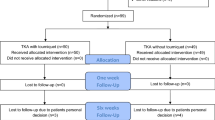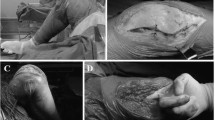Abstract
Purpose
The aim of this study was to evaluate the effect of knee position during wound closure (flexed vs. extended) in total knee arthroplasty on knee strength and function, as determined by knee society scores and isokinetic testing of extensor and flexor muscle groups.
Methods
In a prospective, randomized, double-blind trial, 29 patients were divided in two groups: for Group 1 patients, surgical closing was performed with the knee extended, and for Group 2 patients, the knee flexed at 90°. All the patients were treated with the same anaesthesia method, surgical team, surgical technique, prosthesis type, and rehabilitation process. American Knee Society Score values and knee flexion degrees were recorded. Isokinetic muscle strength measurements of both knees in flexion and extension were taken using 60° and 180°/s angular velocity. The peak torque and total work values, isokinetic muscle strength differences, and total work difference values were calculated for surgically repaired and healthy knees.
Results
No significant difference in the mean American Knee Society Score values and knee flexion degrees was observed between the two groups. However, using isokinetic evaluation, a significant difference was found in the isokinetic muscle strength differences and total work difference of the flexor muscle between the two groups when patients were tested at 180°/s. Less loss of strength was detected in the isokinetic muscle strength differences of the flexor muscle in Group 2 (−4.2 %) than in Group 1 (−23.1 %).
Conclusion
For patients undergoing total knee arthroplasty, post-operative flexor muscle strength is improved if the knee is flexed during wound closure.
Level of evidence
II.



Similar content being viewed by others
Abbreviations
- TKA:
-
Total knee arthroplasty
- IKSS:
-
International knee society score
- PT:
-
Peak torque
- PTA:
-
Peak torque angle
- TW:
-
Total work
- TWD:
-
Total work difference values
- IMS:
-
Isokinetic muscle strength
- IMSD:
-
Isokinetic muscle strength difference
- SD:
-
Standard deviation
References
Chang CH, Chen KH, Yang RS, Liu TK (2002) Muscle torques in total knee arthroplasty with subvastus and parapatellar approaches. Clin Orthop Relat Res 398:189–195
Daglar B, Gungor E, Delialioglu OM, Karakus D, Ersoz M, Tasbas BA, Bayrakci K, Gunel U (2009) Comparison of knee function after antegrade and retrograde intramedullary nailing for diaphyseal femoral fractures: results of isokinetic evaluation. J Orthop Trauma 23:640–644
Dennis DA, Komistek RD, Scuderi GR, Zingde S (2007) Factors affecting flexion after total knee arthroplasty. Clin Orthop Relat Res 464:53–60
Emerson RH Jr, Ayers C, Head WC, Higgins LL (1996) Surgical closing in primary total knee arthroplasties: flexion versus extension. Clin Orthop Relat Res 331:74–80
Emerson RH Jr, Ayers C, Higgins LL (1999) Surgical closing in total knee arthroplasty. A series followup. Clin Orthop Relat Res 368:176–181
Hanratty B, Bennett D, Thompson NW, Beverland DE (2011) A randomised controlled trial investigating the effect of posterior capsular stripping on knee flexion and range of motion in patients undergoing primary knee arthroplasty. Knee 18:474–479
Harvey IA, Barry K, Kirby SP, Johnson R, Elloy MA (1993) Factors affecting the range of movement of total knee arthroplasty. J Bone Joint Surg Br 75:950–955
Insall JN, Dorr LD, Scott RD, Scott WN (1989) Rationale of the knee society clinical rating system. Clin Orthop Relat Res 248:13–14
Kellgren JH, Lawrence JS (1957) Radiological assessment of rheumatoid arthritis. Ann Rheum Dis 16:485–493
King TV, Kish G, Eberhart RE, Holzaepfel JL (1992) The “genuflex” skin closure for total knee arthroplasty. Orthopedics 15:1057–1058
Li B, Wen Y, Liu D, Tian L (2012) The effect of knee position on blood loss and range of motion following total knee arthroplasty. Knee Surg Sports Traumatol Arthrosc 20:594–599
Maloney WJ, Schurman DJ (1992) The effects of implant design on range of motion after total knee arthroplasty. Total condylar versus posterior stabilized total condylar designs. Clin Orthop Relat Res 278:147–152
Masri BA, Laskin RS, Windsor RE, Haas SB (1996) Knee closure in total knee replacement: a randomized prospective trial. Clin Orthop Relat Res 331:81–86
Matsumoto T, Tsumura N, Kubo S, Shiba R, Kurosaka M, Yoshiya S (2005) Influence of hip position on knee flexion angle in patients undergoing total knee arthroplasty. J Arthroplasty 20:669–673
Ritter MA, Berend ME, Harty LD, Davis KE, Meding JB, Keating EM (2004) Predicting range of motion after revision total knee arthroplasty: clustering and log-linear regression analyses. J Arthroplasty 19:338–343
Ritter MA, Harty LD, Davis KE, Meding JB, Berend ME (2003) Predicting range of motion after total knee arthroplasty. Clustering, log-linear regression, and regression tree analysis. J Bone Joint Surg Am 85:1278–1285
Ritter MA, Lutgring JD, Davis KE, Berend ME (2008) The effect of postoperative range of motion on functional activities after posterior cruciate-retaining total knee arthroplasty. J Bone Joint Surg Am 90:777–784
Rosene JM, Fogarty TD, Mahaffey BL (2001) Isokinetic Hamstrings: quadriceps ratios in intercollegiate Athletes. J Athl Train 36:378–383
Sancheti KH, Sancheti PK, Shyam AK, Joshi R, Patil K, Jain A (2013) Factors affecting range of motion in total knee arthroplasty using high flexion prosthesis: a prospective study. Indian J Orthop 47:50–56
Shoji H, Murakami T, Murai I, Kida H, Sato Y, Kojima K, Abe T, Okudera T (1990) A follow-up study by CT and MRI in 3 cases of Japanese encephalitis. Neuroradiology 32:215–219
Smith TO, Davies L, Hing CB (2010) Wound closure in flexion versus extension following total knee arthroplasty: a systematic review. Acta Orthop Belg 76:298–306
Sole G, Hamren J, Milosavljevic S, Nicholson H, Sullivan SJ (2007) Test-retest reliability of isokinetic knee extension and flexion. Arch Phys Med Rehabil 88:626–631
Tibesku CO, Daniilidis K, Vieth V, Skwara A, Heindel W, Fuchs-Winkelmann S (2011) Sagittal plane kinematics of fixed- and mobile-bearing total knee replacements. Knee Surg Sports Traumatol Arthrosc 19:1488–1495
Conflict of interest
No conflicts of interest.
Author information
Authors and Affiliations
Corresponding author
Rights and permissions
About this article
Cite this article
Kömürcü, E., Yüksel, H.Y., Ersöz, M. et al. Effect of surgical closing in total knee arthroplasty at flexion or extension: a prospective, randomized study. Knee Surg Sports Traumatol Arthrosc 22, 3067–3073 (2014). https://doi.org/10.1007/s00167-014-2896-6
Received:
Accepted:
Published:
Issue Date:
DOI: https://doi.org/10.1007/s00167-014-2896-6




